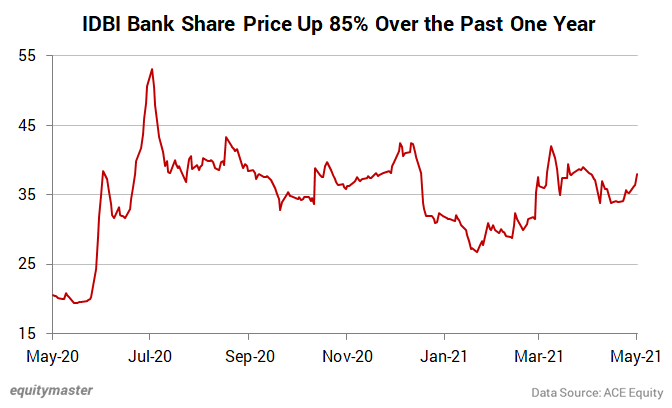India's Third Giant Leap
This Could be One of the Biggest Opportunities for Investors
- Home
- Views On News
- May 6, 2021 - IDBI Bank Gets Strategic Divestment Approval. What's Next?
IDBI Bank Gets Strategic Divestment Approval. What's Next?

Shares of IDBI Bank rose x% today after the bank got CCEA nod for divestment.
The government cleared a proposal for strategic disinvestment of IDBI Bank Ltd which is a step towards its efforts to meet the ambitious Rs 1.75 lakh crore disinvestment target for this fiscal year.
The proposal was approved by the Cabinet Committee on Economic Affairs (CCEA) chaired by Prime Minister Narendra Modi.
It involves the sale of a majority stake in the bank jointly by the government and Life Insurance Corporation of India (LIC), along with management control.
The Union government and LIC own 45.48% and 49.24%, respectively, in IDBI Bank, giving them a combined stake of more than 94%.
LIC is currently the promoter of IDBI Bank with management control after the government sold its majority stake to the state-run insurance giant in 2019.
However, the government and LIC may not fully sell their stakes and instead retain minority holdings post the strategic disinvestment.
"The extent of respective shareholding to be divested by GoI and LIC shall be decided at the time of structuring of transaction in consultation with the RBI," the cabinet secretariat said in a statement.
It was also noted the government will appoint advisers for the transaction. It will also issue the preliminary information memorandum inviting expression of interest for the stake sale.
Expectations of the Proposal
The centre expects a buyer to infuse funds, new technology, and best management practices for growth of IDBI Bank as well as generate business without any dependence on LIC or the government.
The resources raised through strategic disinvestment would be used to finance developmental programs of the government.
The All India Bank Employees' Association said it's a retrograde step and the centre should focus on recovering bad loans due by corporate houses rather than selling it off.
Full-Year Profit in FY21 After 5 Years
IDBI Bank on Monday reported an annual profit for the first time in five years at Rs 13.6 bn for 2020-21. It had reported a loss of Rs 128.9 bn in fiscal 2019-20.
In the March quarter (Q4FY21), the bank reported a nearly four-fold jump in net profit to Rs 5.1 bn due to tax refund and higher net interest income.
While the bank's gross bad loans are still high at 22%, high provisions have helped bring down the net non-performing assets (NPA) ratio to 1.97%.
The bank's capital adequacy ratio was at 15.59% as of the end of March.
Its deposits rose 4% to Rs 2.3 trillion in FY21. The share of low-cost deposits rose to 50.5% in March 2021 from 47.7% in March 2020.
A Look at IDBI Bank and LIC's Checkered Past
In August 2018, the government allowed LIC to buy 51% in IDBI Bank. This was when IDBI Bank was in dire need of capital.
Its bad loans had surged to 28% and the government was reluctant to put in more capital.
The promoter-ship of LIC for the lender, however, came with its own problems. Since LIC had to dip into policyholder funds to finance the stake purchase, the insurance regulator had raised concerns about long-term ownership of IDBI Bank.
Over the last few years, IDBI Bank has been cleaning up its books while being under the RBI's prompt corrective action framework for weak banks. On 10 March 2021, the RBI removed the restrictions placed on the lender.
IDBI Bank Out of Prompt Corrective Action
IDBI Bank came out of prompt corrective action (PCA) after improving its finances and credit profile in March 2021.
This eased the rules for the lender to expand business. It also set the stage for strategic divestment by the government of India, which holds 45.48% stake.
The RBI in a statement said its board for financial supervision had reviewed the performance of IDBI Bank at its meeting on 18 February 2021.
According to published results for the quarter ended 31 December 2020, the bank is not in breach of the PCA parameters on regulatory capital, net non-performing assets (NPAs), and leverage ratio.
IDBI Bank had been under the PCA framework since 2017. The PCA regime places curbs on big-ticket lending and expenditure and calls for a plan for turnaround.
The bank has furnished a written commitment saying it would comply with the norms of minimum regulatory capital, net NPAs, and leverage ratio on an ongoing basis.
IDBI Bank's exit from central bank purgatory has also raised hopes that the remaining three banks under PCA could be next in line for similar relief, having achieved parameters to justify their exit.
The three banks under PCA - Indian Overseas Bank (IOB), UCO Bank, and Central Bank of India - have reported net non-performing assets (NPAs) below levels that trigger PCA.
While IOB was placed under PCA in 2015, the other two joined two years later.
How Stock Markets Reacted to the News
Shares of IDBI Bank witnessed buying interest today and were trading up by 7.3% on the BSE at the time of writing at Rs 40.7 apiece.
IDBI Bank share price has touched a 52-week high of Rs 55.7 and a 52-week low of Rs 19.2.
On a year to date basis, share price of IDBI Bank is up 17% and over the past one year, it has gained a whopping 85% as can be seen from the chart below.

For more details about the company, you can have a look at IDBI Bank fact sheet and IDBI Bank quarterly results on our website.
And to know more about the banking sector in India, you can read our banking sector report.

Monish Vora is a keen student of the markets and shares his observations through his clear and concise commentary.


Equitymaster requests your view! Post a comment on "IDBI Bank Gets Strategic Divestment Approval. What's Next?". Click here!
Comments are moderated by Equitymaster, in accordance with the Terms of Use, and may not appear
on this article until they have been reviewed and deemed appropriate for posting.
In the meantime, you may want to share this article with your friends!